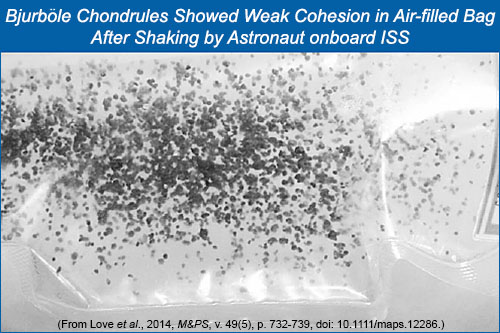Quick Views of Big Advances
Investigating Particle Clumping in Microgravity
NASA Astronauts Stanley Love and Donald Pettit and NASA researcher Scott Messenger used the International Space Station's microgravity environment to run experiments on clumping of solid particles. The results have interesting relevance to the studies of how aggregates formed in the solar nebula and the ultimate growth of asteroids and planets.

|
Pettit conducted the experiments in microgravity, in off-duty time during three space missions, using materials at hand (salt, sugar, coffee) as well as chondrules (1.7 mm average diameter) from the meteorite Bjurböle [Data link from the Meteoritical Bulletin], rock fragments (4-7 mm in size) crushed from the meteorites Allende [Data link from the Meteoritical Bulletin] and Allan Hills A76009 [Data link from the Meteoritical Bulletin], acrylic and glass beads, and mixtures of particle types.

|
In every trial using salt, sugar, and coffee, the majority of particles clumped spontaneously after a few seconds of thorough shaking. The clumps survived impacts with the wall of the bag, but broke under stronger shaking. On the other hand, the Bjurböle chondrules exhibited very little cohesion. The results showed no simple relationship between the speed and strength of aggregation with the variables of number density, composition, particle shape, or surface roughness. Trials using meteorite fragments or acrylic beads or glass beads did not clump at all. Mixtures of sugar with meteorite fragments and beads formed clumps dominated by sugar with incidental capture of some of the other materials. The preferential clumping of these mixtures demonstrated that particles that do not readily cluster together can still be incorportated into aggregates with other, more cohesive, materials. While no one assumes the results of these informal experiments can be applied to the whole story of planet formation, they are eye-opening as to what they reveal about the actions of millimeter-sized particles in microgravity. Modeling the growth of asteroids and planets in a real nebula, as this and previous research studies show, requires consideration of epic details such as cosmic rays, gas pressure, gas turbulence, temperature, electrical charging, and such things beyond the scope of Saturday morning science experiments.
The informal experiments described by Love, Pettit, and Messenger support the electrostatic model for particle aggregation in the solar nebula and serve as a spring board for more sophisticated future investigations of the aggregate behavior of millimeter- and submillimeter-sized particles in microgravity.
![]() (pdf version)
(pdf version)
See Reference:
· Love, S. G., Pettit, D. R., and Messenger, S. R. (2014) Particle Aggregation in Microgravity: Informal Experiments on the International Space Station, Meteoritics & Planetary Science, v. 49(5), p. 732-739, doi: 10.1111/maps.12286. [ abstract ]
See also:
· Don Pettit–Space Chronicles
· Building Planets in Plastic Bags by David Tytell, Sky & Telescope.
Written by Linda Martel, Hawai'i Institute of Geophysics and Planetology, for PSRD.
|
|
[ About PSRD | Archive | CosmoSparks | Search | Subscribe ] [ Glossary | General Resources | Comments | Top of page ] |
